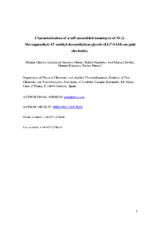Characterization of a self-assembled monolayer of O-(2-Mercaptoethyl)-O′-methyl-hexa(ethylene glycol) (EG7-SAM) on gold electrodes
Autor
Chávez, Miriam
Sánchez-Obrero, Guadalupe
Madueño, Rafael
Sevilla, José Manuel
Blázquez, Manuel
Pineda, Teresa
Editor
ElsevierFecha
2021Materia
Polyethylene glycolSelf-assembled monolayer
Gold
Cyclic voltammetry
Electrochemical impedance spectroscopy
Infrared spectroscopy
X-ray photoelectronic spectroscopy
Contact angle measurements
Electrochemical quartz crystal microbalance
METS:
Mostrar el registro METSPREMIS:
Mostrar el registro PREMISMetadatos
Mostrar el registro completo del ítemResumen
The modification of surfaces by polyethylene glycol (EGn) is an approach used to reduce the antifouling effects of these materials in a biological medium. It has been found that the packing density and conformational order of these molecules in the films are crucial for the inhibition of unspecific protein adsorption. In this work, we present a study of the formation and characterization of a self-assembled monolayer of O-(2-Mercaptoethyl)-O′-methyl hexa(ethylene glycol) (EG7-SAM) on either poly-oriented or Au(111) single crystal surfaces. The final properties of the formed EG7-SAMs are studied by examining the reductive desorption process as well as the electronic and ionic blocking behavior of these layers, under different experimental conditions, by using cyclic voltammetry and electrochemical impedance spectroscopy. Additional information of the structure, composition and organization is obtained by absorption-reflection infrared and X ray photoelectron spectroscopies and contact angle measurements. In contrast to the behavior observed with alkanethiols, the EG7-SAM shows the best final organization at a modification time of 1h. The antifouling properties of this EG7-SAM against the adsorption of the bovine serum albumin protein in a phosphate saline medium, has been evidenced by using the electrochemical quartz crystal microbalance technique.

